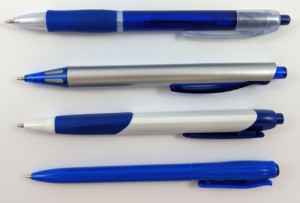 I was on a quest, a quest to find the cheapest ballpoint pen possible. And what I found was amazing. Modern manufacturing has achieved stunning productivity, where even a complex product like a ballpoint pen can be produced at costs that were unbelievable only a few decades ago. While everybody can make a pen, the goal in manufacturing is always to make it cheaper! For the same functionality, the customer will almost always go for the cheaper products. Let me show you the results of my quest.
I was on a quest, a quest to find the cheapest ballpoint pen possible. And what I found was amazing. Modern manufacturing has achieved stunning productivity, where even a complex product like a ballpoint pen can be produced at costs that were unbelievable only a few decades ago. While everybody can make a pen, the goal in manufacturing is always to make it cheaper! For the same functionality, the customer will almost always go for the cheaper products. Let me show you the results of my quest.
The Product
The product I was after is simple. A ballpoint pen with a retractable point. You all used it at one point or another. With cheap pens you probably don’t bother with replacing the ink reservoir, but simply throw out the pen when it is empty, unless of course you lost the pen beforehand. Pens nowadays are so cheap, it is just not worth fixing them. I wanted to see how cheap I could get. The price I was looking at was for bulk purchase (think 100,000 pens or so) and would not include shipping and value added taxes.
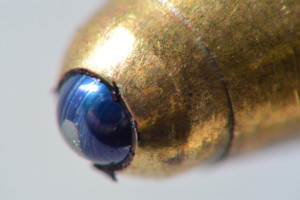 But please be reminded that a pen is a by no means simple product. It has multiple moving parts, including a precision ball in a socket that gave the pen its name. This ball is often made out of tungsten carbide for reduced wear, although I could not analyze the material of my quest pens.
But please be reminded that a pen is a by no means simple product. It has multiple moving parts, including a precision ball in a socket that gave the pen its name. This ball is often made out of tungsten carbide for reduced wear, although I could not analyze the material of my quest pens.
There is also a mechanism for the retracting and extending of the tip and the ink reservoir. Overall, it is a complex product with quite a few engineering specifications and tolerances.
The Pens
Pen 1: Manors
The first cheap pen I found – surprisingly enough – in Germany. For a measly EUR 0.0637 (around USD 0.0723) I get a working pen (for quantities of 70,000 and up). And – second surprise – it is actually a pretty decent pen. It writes well, the retracting mechanism feels good, it does not look ugly, and it even has a small rubber grip to make it easier to hold. When I say it writes well, I mean of course for a low-cost pen. Naturally, you can find high-end pens that promise eternal bliss while writing, but if you just want to get a line on the paper, this is good enough. Altogether this pen is made of eleven components. Since I bought only around fifteen pens, I had to pay around €5 in shipping for €0.95 worth of pens
Pen 2: Wessex
On the same site I found an even cheaper pen for only EUR 0.0606 (USD 0.0688) (for quantities of 75,000 and up). Since it did not have a nice rubber grip, it felt a bit cheaper, and to me it also looked a bit cheaper, even though the barrel had a metallic finish (still plastic though) and the tip had a fancy over-mold, where the blue part seems to have been directly molded on top of the gray part. This makes the mold a bit more expensive. Since each pen was in a clear plastic bag, the product still had eleven parts, although I could not disassemble the clip without breaking it.
Pen 3: No Name
Next I set my sights on the source of probably most pens in the world: China! And a good site to browse Chinese products is Alibaba. Here I found my next quest item from the Yiwu JC Import & Export Co., Ltd., a pen for a whopping USD 0.0450 (EUR 0.0396) (price asked for a quantity of 115,000). This one also looked nice and had a rubber grip. The design was also not bad. As part of the assembly, the end cap was screwed onto the thrust tube, hence the mold for both the end caps and the thrust tube needed a thread. The clip was also glued on. With altogether thirteen parts (including glue), it had the highest number of parts of the pens I looked at in more detail.
Pen 4: No Name
The same source at Alibaba also had an even cheaper pen for USD 0.035 (EUR 0.0308)(price asked for a quantity of 115,000). But now it starts to look and feel cheap. The pen still writes well, but they did save money on the clip mechanism. Rather than clipping with your thumb on the end cap, the end cap only pushes it in until the integrated clip arrests. A second press on the clip releases the reservoir again and it jumps back out. Hence, you have to press different locations for extending and retracting the tip. This pen has only seven different parts, the lowest of any of these four pens. However, I feel for USD 0.035 I cannot complain (although including shipping I paid $5 per sample pen). Shipping for 115,000 pens to Germany would have been $300 within forty to forty-five days.
How Do You Make a Pen for USD 0.035???
While pen #4 was definitely not the nicest pen, it was the cheapest, and hence I will look at this one in more detail. How on earth do you make a pen for USD 0.035 per pen?
Let’s put this in perspective. Among the cheapest industrial wages paid in the world are around $1 per hour. You can get cheaper wages, but then the workers would not know how a light switch works, and would need to be trained before they can be used in industry – at which time they would commandeer higher wages. Even $1/hour is a bit extreme, especially since I do not include taxes and other overhead. But for the sake of the argument, let’s stick with $1.
At $1/hour you will get for $0.035 a measly 2 minutes and six seconds. Hence, the entire labor in making this pen is less than 2.1 minutes! While this does not sound like much for assembling a pen, this 2.1 minutes also includes the mining, processing, shipping, and manufacturing of the pen.
You have to get the metals out of the ground as well as the oil for the plastic and ink. These have to be processed, formed, shaped, transformed, molded, and assembled. All of this needs (expensive) equipment. Do not forget the work of the engineers designing this pen as well as all the different machines, and they usually do not work for $1 per hour. Also do not forget logistics, energy, and a lot of other things.
The total human contribution is probably way less than 2 minutes. All the other contribution is through machines, automation, and other mechanical gadgets and gizmos. But if you buy a $0.035 pen, an infinitesimal small fraction of the money goes to the oil rig, the mine, and many other companies. The contribution is probably too small to measure, but it is making a profit for the industry!
Below is an overview of the components with their weight (measured), the material (educated guess), material cost (polypropylene $1/kg, steel $0.60/kg, ink $1/kg), and a very rough estimate of the production cost assuming production in very large quantities. I also added a generous half a cent for the final assembly. The total cost of the pen is probably USD 0.0051 for material and 0.015 for manufacturing for a total of USD 0.021 before profit and shipping (or less, I am not that familiar with Chinese prices). Still, amazingly cheap.
| Component | Weight (g) | Material | Material Cost ($) | Production Cost ($) |
|---|---|---|---|---|
| Barrel | 3.519 | Polypropylene | 0.0035 | 0.0033 |
| Rear Cap | 0.826 | Polypropylene | 0.00083 | 0.0033 |
| Spring | 0.175 | Steel | 0.00011 | (n/a) |
| Mine Assembly | 0.731 | (assembly) | n/a | 0.00047 |
| Ball | 0.0003 | Steel | 0.00000018 | 0.00064 |
| Ball Socket | 0.159 | Steel | 0.000095 | 0.0032 |
| Ink | 0.098 | Pixie Dust? | 0.00098 | n/a |
| Reservoir | 0.474 | Polypropylene? | 0.00047 | 0.0034 |
| Total | 5.2513 | 0.0051 | 0.015 |
By the way, the hardest and most high-tech part to make is the ball and the ball socket. Until recently, China had to import all balls from Japan and Europe, since they did not have the technology to make them. The Yiwu JC Import & Export Co., Ltd. that made the two pens above also produces their own balls and ball sockets.
Can It Be Even Cheaper?
It can definitely be cheaper. If not now, then definitely in the future as manufacturing continues to advance and become even more productive. But probably even now you can find cheaper pens, although I believe not by much. I found even cheaper pens advertised, but these prices turned out to be doubtful.
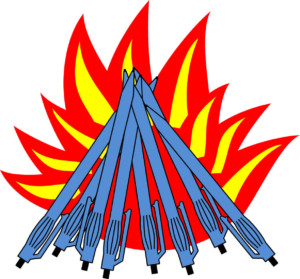
Amazon has plenty of pens for USD 0.01, but they come with $3 for shipping, and I guess the profit is in the shipping. The cheapest pen I saw advertised on Alibaba was less than half a cent at USD 0.004 (EUR 0.0035), but the supplier never returned my messages. Another pen advertised as USD 0.01 was not available at this price.
I guess the price was just to get my attention and not really an offer. Besides, at USD 0.004 for a 7g (0.24 ounce) pen, the pen has the same price by weight as heating oil. You may just as well heat your apartment by burning pens.
What About the Other End?
Of course, there is not really a firm upper limit on the price of ballpoint pens. At the time of writing, the most expensive ballpoint pen on Amazon.com was the Limited Edition Montegrappa Ernest Hemingway Traveller Ballpoint Pen, Gold 18k for USD 39,150.00 (and don’t forget the 5.99 shipping).
For the same price you get 1,118,571 pens at 0.035 each. Is the writing of this Hemingway pen truly one million times better? I doubt it. But it does make a great conversation piece. Although for that price I still would rather buy two cars. Besides, with a weight of 99g (3.5 ounces), it is quite a hefty piece.
Summary
Please excuse me for getting a bit misty-eyed, but I find it just utterly amazing how much modern industry can make things cheaper and cheaper … and the journey is long from being over. As we speak, thousands of engineers, technicians, workers, and industrialists work on making their products even cheaper.
So, no matter if your work improves price, speed, or quality, it does not only improve your companies bottom line, but you are also a part of human ingenuity that constantly works on improving their products and its production. Your work contributes to human prosperity! Now go out, shave a few more cents out of the product, bring humanity forward a bit more, and organize your industry!
Pen Sources
- Pen 1 Manor at werbeartikel-discount.com
- Pen 2 Wessex also at werbeartikel-discount.com
- Pen 3 & 4 from the Yiwu JC Import & Export Co., Ltd. on Alibaba

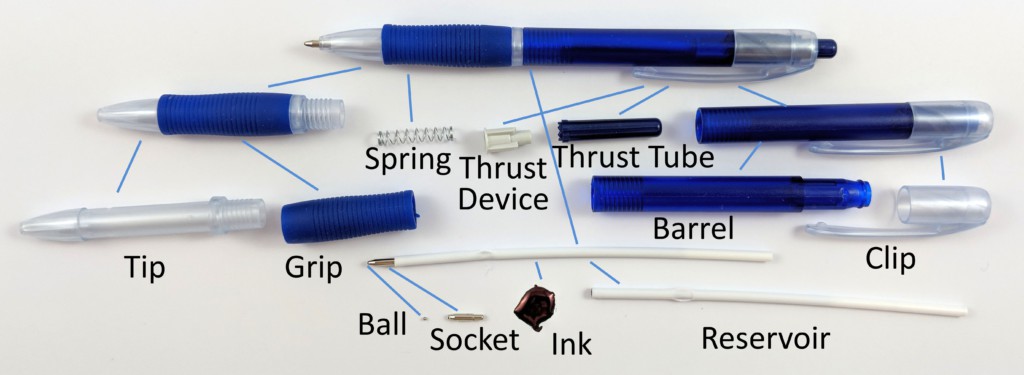
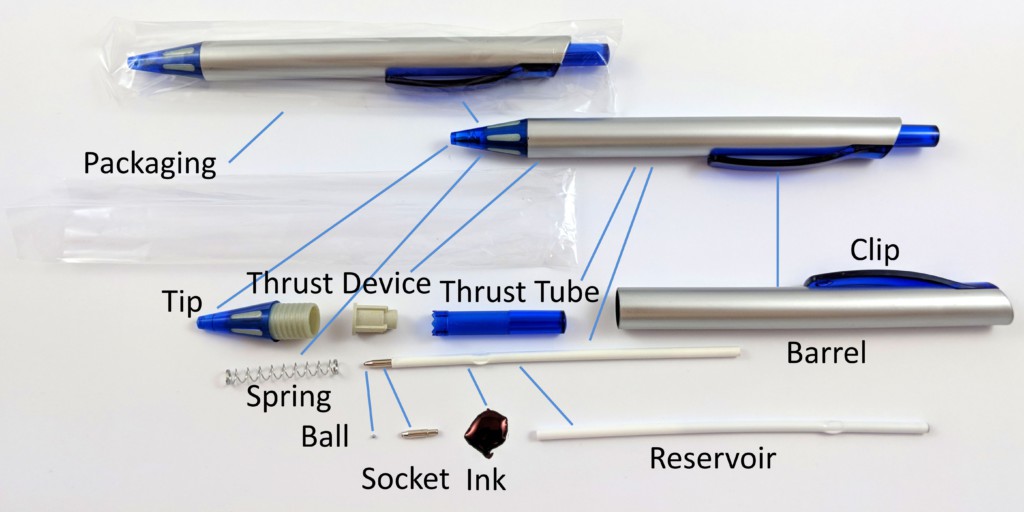



Brilliant article, thank you
Very well written. Exhaustive and convincing! Keep them coming!
It’s not cheap. Usually cheapness is compensated back into economy when a plastic-poisoned person splurges on cancer treatment
Great article, thank you!
I do have a thought still- are you confident that the low prices were not primarily due to the items being classified as SMOI by the sales organization?
Hi T Cook, assuming that by SMOI you mean Slow Moving and Obsolete Inventory, I did request price for a large quantity of 100 000 pcs. By the look and feel of the pens I believe they are currently still under production. Even if by chance one of them by one company is SMOI, the others probably are not. But these are all just guesses on my side.
Hopefully we can also include this mindset of simplification to the essence in our currently unwieldy administrative structure
Administration is difficult. The problem is often the large number of non-recurring tasks, political influence, and a disconnect from the value for the customer.
You definitely need to visit India. Cheapest pen here sold in retail is for INR 2 i.e 0.026.
We are using it since 8-10 years!
Nice! Even cheaper!